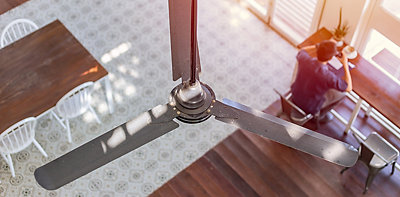How to Use Your Ceiling Fan with Your Air Conditioner to Save Money

March 14, 2024
Blasting the AC when San Jose temperatures soar to 109 may bring comfort to your home, but it doesn’t make opening your energy bill any more pleasant. While instinct may tell you to turn off your ceiling fan in favor of your AC’s blasts of cold air, using them together is the key to saving money during the California summer.
With a little strategy, such as adjusting the ceiling fan direction with air conditioning on, you can enjoy savings without sacrificing comfort.
Benefits of Using Ceiling Fans with Air Conditioning
Although ceiling fans don’t lower the temperature in your home the way air conditioning does, running a fan simultaneously with AC can offer certain advantages over just running one or the other:
Wind chill effect: While it doesn’t actually lower the temperature, the breeze of a ceiling fan evaporates humidity from your skin and lowers body heat.
Circulation: Ceiling fans help circulate the cold air from the AC for more even temperature distribution.
Energy efficiency: The wind chill effect and improved circulation of a ceiling fan means your AC system, which uses significantly more energy, doesn’t have to work as hard to achieve a similar cooling sensation.
Cost savings: On average, air conditioning costs about 36 cents per hour vs. ceiling fans at one cent per hour. When your AC system isn’t working as hard, it shows in energy bill savings.
Reduced wear: By offsetting some of the strain from the AC to the ceiling fan, you can extend the lifespan of your AC system.
How To Use Your Ceiling Fan Effectively
Maximize your comfort and energy bill savings with the following ceiling fan tips.
Understanding ceiling fan direction
Ceiling fans can run in both directions, with a clockwise rotation creating an upward draft and a counterclockwise rotation creating a downward draft for most fan models. During the summer, set your fan to run counterclockwise to best circulate cool air around the room.
Find the switch to change the direction either on the base of the fan or on the remote control. Check that the fan creates a noticeable breeze when you’re standing underneath.
Use the right ceiling fan size and position
Correctly sizing and positioning your ceiling fan according to your space helps ensure its optimal performance. Swapping out an existing fan or light fixture for a better-performing ceiling fan is a fairly straightforward task.
Fans between 36 and 44 inches are best for rooms up to 225 square feet and can efficiently cool a 4 to 6-foot diameter, and 52-inch and bigger fans perform well in spaces larger than 225 square feet and can cool within a 10-foot diameter.
To avoid obstructions, position the fan so the blades have at least eight inches of clearance from the ceiling and 18 inches from the walls. Keep in mind that long or irregularly shaped rooms can inhibit the fan’s airflow and may require additional fans.
Turn up the thermostat
If you only turn on your fan without adjusting the thermostat, you’ll use more energy than without it. To enjoy energy savings, set your thermostat between two and four degrees colder. With the wind chill effect from the ceiling fan making the room feel colder than its actual temperature, you likely won’t notice any difference in comfort.
Turn off fans in unoccupied rooms
Since fans only create a wind chill effect and don’t lower the actual temperature, there’s no need to run the fan where nobody will feel it. While ceiling fans use a fraction of energy compared to AC systems, it’s still wasted energy if your fan is running in an empty room. Make sure to turn ceiling fans off whenever you’re the last person to leave the room.
Tips for Ceiling Fan Maintenance
Ceiling fans work year-round to make your home comfortable and lower your energy bills, but they also need regular maintenance to keep them operating efficiently. If you notice unusual sounds, wobbling, or slow rotations, it’s time to check your fan.
Keep your ceiling fan in good shape by following these maintenance tips:
Vacuum and dust: Using a vacuum attachment or duster, remove dust from the blades and exposed parts of the fixture.
Tighten screws: Inspect the fan for any loose screws or components and tighten them as needed.
Check blades: Blades can warp, bend, or sustain other damage over time and cause wobbling. Inspect each blade, repairing or replacing them as needed according to the manufacturer’s guidelines.
Lubricate: Older fan models sometimes require top-ups to their oil reservoirs to keep them lubricated. Check your owner’s manual for model-specific oiling requirements.
Enjoy Cool Rooms and Cost Savings All Summer
When the California summer heat rolls in, pairing your AC with a ceiling fan is your best defense. By correctly setting the fan’s direction, adjusting the thermostat, and a few other simple strategies, you can keep your home cool without driving up your energy bill.
If you need assistance with your AC or other home systems, don’t hesitate to call one of our AC technicians at Service Champions. With more than 200,000 clients served across the Santa Clara, Sacramento Valley, Alameda, and Contra Costa areas and thousands of five-star reviews, we’re available 24/7 to deliver award-winning services. Contact us or book online today for top-notch AC maintenance, repairs, and installation.
Frequently Asked Questions
What ceiling fan speed should I use with AC?
The ideal ceiling fan speed when paired with AC depends on a few factors. A high speed can generate the most amount of wind chill effect, but it consumes more energy and may generate more noise. Test your ceiling fan speeds to find the right balance.
Do ceiling fans work better with the windows closed?
If the air outside is warmer than the ideal indoor temperature, it’s best to keep the windows closed and rely on the AC to provide cold air for your fan to circulate.
